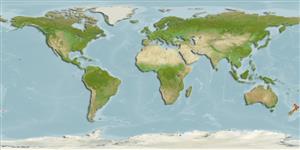Environment: milieu / climate zone / depth range / distribution range
पारिस्थितिकी
समुद्री प्रवाल-भित्ति संयुक्त; गहराई सीमा 4 - 110 m (Ref. 13227), usually 4 - 20 m (Ref. 13227). Temperate
Southwest Pacific: New Zealand.
आकार / वज़न / Age
Maturity: Lm ? range ? - ? cm
Max length : 5.0 cm SL पुल्लिंग / अलिंग; (Ref. 13227)
Short description
आकृति विज्ञान | मौरफोमैटरिक्स
पृष्ठीय रीढ़ (सम्पूर्ण): 23 - 27; पृष्ठीय सौफट रेज़ (सम्पूर्ण): 12-15; गुदा कांटा 2; ऐनल सौफट रेज़: 25 - 30; जानवरों की रीड़ का जोड़: 39 - 46. Short denticles present on inter-radial circuli. Pterygiophore supporting first segmented ray of third dorsal fin anterior to neural spine of 25th vertebra. Dorsal fin formula V-0N-0-1-0-
1. Nine procurrent rays in upper caudal lobe, 8 in lower lobe; in upper lobe 1 ray between upper lobe and posterior epural, 5 rays opposite epurals, 3 rays anterior to anterior epural; in lower lobe, 1 ray between lower lobe and haemal spine of second preural vertebra, 6 rays opposite haemal spine of third preural vertebra, 1 ray anterior to haemal spine of third preural vertebra. Front of body white with black eyes, black stripe extending to below base of second dorsal fin, rear part of body white or yellow; body yellow with black head in breeding males, females and non-breeding males white anteriorly, white or yellow posteriorly, with black stripe along lateral line, only reaching to mid-body (Ref. 84085).
Facultative air-breathing in the genus (Ref. 126274); Adults usually inhabit rocky reefs (Ref. 84085). They are found on the sides or under overhangs of large boulders, sheltering in the massive sponge growths or in large, deep crevices. They feed mainly on amphipods, and also on barnacle cyprids and polychaete larvae. Males maybe territorial during the breeding season (Ref. 13227). Eggs are hemispherical and covered with numerous sticky threads that anchor them in the algae on the nesting sites (Ref. 240). Larvae are planktonic which occur primarily in shallow, nearshore waters (Ref. 94114).
Life cycle and mating behavior
परिपक्व अवधि | पुनरुत्पत्ति | मछलीऔ का अंडे देना | अंडे | Fecundity | लार्वा
Fricke, R., 1994. Tripterygiid fishes of Australia, New Zealand and the southwest Pacific Ocean (Teleostei). Theses Zool. 24:1-585. (Ref. 13227)
IUCN Red List Status (Ref. 130435)
Threat to humans
Harmless
Human uses
मात्स्यिकी: कोई रुचि बग़ैर
अधिक जानकारी
आम नामउपशब्दचपायचयपरभक्षीईकोटोकसीकोलौजीपुनरुत्पत्तिपरिपक्व अवधिमछलीऔ का अंडे देनाSpawning aggregationFecundityअंडेEgg development
Age/Sizeबाढ़Length-weightLength-lengthLength-frequenciesमौरफोमैटरिक्सआकृति विज्ञानलार्वालारवल गतिकीभर्तीबहुतायतBRUVS
संदर्भजलीयकृषिजलीयकृषि रूपरेखाखींचआनुवंशिकीElectrophoresesहैरेटिबिलटीबीमारीप्रक्रमणNutrientsMass conversion
सहयोगीयोतस्वीरेStamps, Coins Misc.ध्वनिसिगुयटिरारफ्तारतैरने के प्रकारगिल क्षेत्रOtolithsदिमागदृष्टि
साधन
Special reports
Download XML
इंटरनेट स्रोत
Estimates based on models
Preferred temperature (Ref.
123201): 13.5 - 22.4, mean 18.4 °C (based on 24 cells).
Phylogenetic diversity index (Ref.
82804): PD
50 = 0.5039 [Uniqueness, from 0.5 = low to 2.0 = high].
Bayesian length-weight: a=0.00562 (0.00258 - 0.01228), b=3.08 (2.89 - 3.27), in cm total length, based on LWR estimates for this (Sub)family-body shape (Ref.
93245).
Trophic level (Ref.
69278): 3.3 ±0.44 se; based on food items.
लौटाव (Ref.
120179): ऊंचा, न्यूनतम जनसंख्या दुगनी समय अवलागत 15 महीने। (Preliminary K or Fecundity.).
Fishing Vulnerability (Ref.
59153): Low vulnerability (10 of 100).
Nutrients (Ref.
124155): Calcium = 97.8 [37.9, 286.6] mg/100g; Iron = 0.57 [0.21, 1.26] mg/100g; Protein = 18.4 [16.8, 20.0] %; Omega3 = 0.314 [0.101, 0.983] g/100g; Selenium = 13.5 [3.7, 47.1] μg/100g; VitaminA = 41.2 [6.0, 250.7] μg/100g; Zinc = 1.76 [0.89, 3.24] mg/100g (wet weight);
